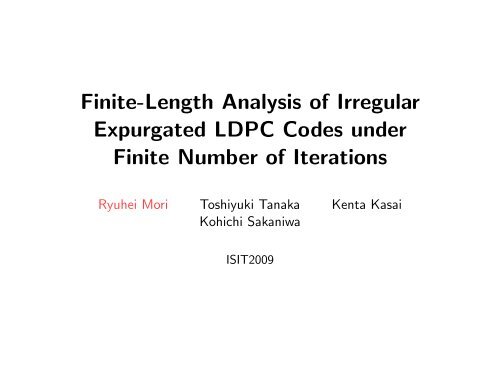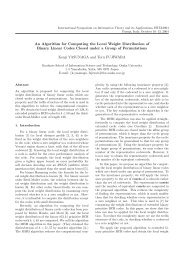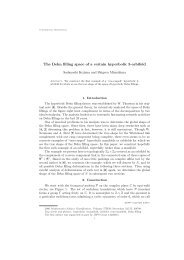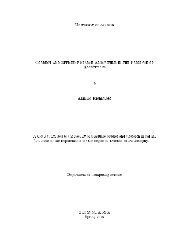Finite-Length Analysis of Irregular Expurgated LDPC Codes under ...
Finite-Length Analysis of Irregular Expurgated LDPC Codes under ...
Finite-Length Analysis of Irregular Expurgated LDPC Codes under ...
You also want an ePaper? Increase the reach of your titles
YUMPU automatically turns print PDFs into web optimized ePapers that Google loves.
<strong>Finite</strong>-<strong>Length</strong> <strong>Analysis</strong> <strong>of</strong> <strong>Irregular</strong><br />
<strong>Expurgated</strong> <strong>LDPC</strong> <strong>Codes</strong> <strong>under</strong><br />
<strong>Finite</strong> Number <strong>of</strong> Iterations<br />
Ryuhei Mori Toshiyuki Tanaka Kenta Kasai<br />
Kohichi Sakaniwa<br />
ISIT2009
<strong>LDPC</strong> codes over the binary erasure channel<br />
The aim <strong>of</strong> our research<br />
To estimate the bit error probability P b (n, ǫ, t) <strong>of</strong> <strong>LDPC</strong> codes<br />
over the BEC <strong>under</strong> belief propagation decoding<br />
where<br />
■<br />
■<br />
■<br />
n: blocklength<br />
ǫ: erasure probability <strong>of</strong> BEC<br />
t: the number <strong>of</strong> iterations<br />
2 / 15
Previous Results<br />
<strong>Analysis</strong> for the BEC<br />
Exact or<br />
Asymptotic<br />
Blocklength<br />
Number <strong>of</strong><br />
Iterations<br />
Computational<br />
Complexity<br />
<strong>Irregular</strong><br />
Ensembles<br />
Method<br />
Exact ∞ t O(t) ○ Density Evolution [1]<br />
Exact n ∞ O(n 3 ) △ Stopping Sets [2]<br />
Asymptotic n ∞ O(1) ○ Scaling Law [3]<br />
Asymptotic n t O(t 3 ) ×→ ○ This Research<br />
[1] Richardson and Urbanke 2001<br />
[2] Di et al. 2002<br />
[3] Amraoui et al. 2004<br />
The Main Result <strong>of</strong> This Work<br />
Our result presented in ISIT2008 is generalized for irregular ensembles<br />
3 / 15
Asymptotic Expansion<br />
Asymptotic Expansion w.r.t n while t is fixed<br />
P b (n, ǫ, t) = P b (∞, ǫ, t) + α(ǫ, t) 1 n + O ( 1<br />
n 2 )<br />
Coefficient <strong>of</strong> 1/n<br />
α(ǫ, t) := lim<br />
n→∞ n (P b(n, ǫ, t) − P b (∞, ǫ, t))<br />
Approximation<br />
P b (n, ǫ, t) ≈ P b (∞, ǫ, t) + α(ǫ, t) 1 n<br />
Our purpose is to derive α(ǫ, t) for irregular ensembles<br />
4 / 15
Neighborhoods<br />
P b (n, ǫ, t) =<br />
∑<br />
P n (G)P b (G, ǫ)<br />
G ∈ the set <strong>of</strong> all neighborhoods <strong>of</strong> depth t<br />
P b (G, ǫ)<br />
ε(1−(1−ε) 2 ) 2 ε 2 (1−(1−ε) 2 ) ε 3 ε(1−(1−ε) 2 ) ε 2 (1+ε(1−ε)) ε<br />
P n (G)<br />
(2n-6)(2n-8)<br />
(2n-1)(2n-5)<br />
2(2n-6)<br />
(2n-1)(2n-5)<br />
1<br />
(2n-1)(2n-5)<br />
2<br />
(2n-1)(2n-5)<br />
4(2n-6)<br />
(2n-1)(2n-5)<br />
2<br />
(2n-1)<br />
Order <strong>of</strong> P n (G)<br />
-1 -2 -2 -1 -1<br />
1 n n n n n<br />
G<br />
5 / 15
Number <strong>of</strong> cycles<br />
The basic fact<br />
If G has k cycles<br />
P n (G) = Θ(n −k ).<br />
The large blocklength limit <strong>of</strong> the bit error probability<br />
P b (∞, ǫ, t) = lim<br />
n→∞<br />
= lim<br />
n→∞<br />
∑<br />
P n (G)P b (G, ǫ)<br />
G ∈ the set <strong>of</strong> all neighborhoods <strong>of</strong> depth t<br />
∑<br />
P n (G)P b (G, ǫ) .<br />
G ∈ the set <strong>of</strong> all cycle-free neighborhoods <strong>of</strong> depth t<br />
6 / 15
Calculation <strong>of</strong> α(ǫ, t)<br />
α(ǫ, t) := lim<br />
n→∞ n(P b(n, ǫ, t) − P b (∞, ǫ, t))<br />
⎛<br />
= lim n ⎝ ∑ P n (G)P b (G, ǫ) − P b (∞, ǫ, t)<br />
n→∞<br />
G ∈ the set <strong>of</strong> all cycle-free neighborhoods <strong>of</strong> depth t<br />
} {{ }<br />
β(ǫ, t)<br />
⎞<br />
⎠<br />
+ lim n ∑ P n (G)P b (G, ǫ)<br />
.<br />
n→∞<br />
G ∈ the set <strong>of</strong> all single-cycle neighborhoods <strong>of</strong> depth t<br />
} {{ }<br />
γ(ǫ, t)<br />
In the previous work [Mori et al., ISIT2008],<br />
γ(ǫ, t) was obtained for irregular ensembles<br />
but β(ǫ, t) was obtained only for regular ensembles<br />
7 / 15
Contribution <strong>of</strong> Cycle-Free Neighborhoods<br />
β(ǫ, t) =<br />
⎛<br />
1<br />
⎝E<br />
2L ′ t [K(K − 1)P] − ∑ (1)<br />
i<br />
i<br />
λ i<br />
E t [V i (V i − 1)P] − ∑ j<br />
⎞<br />
j<br />
E t [C j (C j − 1)P] ⎠<br />
ρ j<br />
The expectations are taken on the tree ensemble <strong>of</strong> depth t<br />
P ∞ (G) := lim<br />
n→∞ P n(G)<br />
■<br />
■<br />
■<br />
■<br />
K: the number <strong>of</strong> edges in a tree neighborhood<br />
V i : the number <strong>of</strong> variable nodes <strong>of</strong> degree i in a tree neighborhood<br />
C j : the number <strong>of</strong> check nodes <strong>of</strong> degree j in a tree neighborhood<br />
P: the erasure probability <strong>of</strong> the root node after BP decoding<br />
on a tree neighborhood<br />
8 / 15
Method <strong>of</strong> Generating Function<br />
E t [K(K − 1)P] = ∂2 E t [x K P]<br />
∂x 2 ∣ ∣∣∣x<br />
= 1<br />
E t [V i (V i − 1)P] = ∂2 E t [x V iP]<br />
∂x 2 ∣ ∣∣∣x<br />
= 1<br />
E t [C j (C j − 1)P] = ∂2 E t [x C jP]<br />
∂x 2 ∣ ∣∣∣x<br />
= 1<br />
E t [x K P] = 1 x E t<br />
E t [x V i<br />
P] = E t<br />
[ ∏<br />
k<br />
E t [x C j<br />
P] = E t<br />
[ ∏<br />
k<br />
[ ∏<br />
k<br />
y V k<br />
k<br />
y V k<br />
k<br />
y V k<br />
k<br />
∏<br />
l<br />
∏<br />
l<br />
∏<br />
l<br />
z C l<br />
l<br />
P<br />
z C l<br />
l<br />
P<br />
z C l<br />
l<br />
P<br />
]∣ ∣∣∣∣yk<br />
= x, z l = x for all k, l<br />
]∣ ∣∣∣∣yi<br />
= x, y k = 1, z l = 1 for all k ≠ i, l<br />
]∣ ∣∣∣∣zj<br />
= x, y k = 1, z l = 1 for all k, l ≠ j<br />
9 / 15
The Mother Generating Function<br />
where<br />
and where<br />
E t<br />
[ ∏<br />
k<br />
F(t) :=<br />
y V k<br />
k<br />
∏<br />
l<br />
z C l<br />
l<br />
P<br />
]<br />
= ǫL(F(t)),<br />
{<br />
1, if t = 0<br />
P(g(t)) − P(G(t)), otherwise,<br />
G(t) := L(f (t − 1)) − ǫL(F(t − 1)),<br />
{<br />
1, if t = 0<br />
f (t) :=<br />
P(g(t)), otherwise,<br />
g(t) := L(f (t − 1)),<br />
L(x) := ∑ i<br />
L i y i x i ,<br />
L(x) := ∑ i<br />
λ i y i x i−1 ,<br />
P(x) := ∑ j<br />
ρ j z j x j−1 .<br />
10 / 15
α(ǫ, t) for Optimized <strong>Irregular</strong> Ensemble<br />
15<br />
10<br />
α(ǫ, t)<br />
5<br />
0<br />
-5<br />
0 0.1 0.2 0.3 0.4 0.5 0.6 0.7 0.8 0.9 1<br />
ǫ<br />
λ(x) = 0.500x + 0.153x 2 + 0.112x 3 + 0.055x 4 + 0.180x 8<br />
ρ(x) = 0.492x 2 + 0.508x 3 R ≈ 0.192, ǫ BP ≈ 0.8, t = 1, 2, ... , 8, 50<br />
11 / 15
Simulation Results<br />
10 2 0.5 0.6 0.7 0.8 0.9 1<br />
n|Pb(n, ǫ, t) − Pb(∞, ǫ, t)|<br />
10 1<br />
10 0<br />
10 -1<br />
10 -2<br />
|α(ǫ, t)|<br />
n=360<br />
n=720<br />
n=5760<br />
λ(x) = 0.500x + 0.153x 2 + 0.112x 3 + 0.055x 4 + 0.180x 8<br />
ρ(x) = 0.492x 2 + 0.508x 3 R ≈ 0.192, ǫ BP ≈ 0.8, t = 20<br />
ǫ<br />
12 / 15
Ensembles with λ 2 = 0<br />
10 1 0.15 0.2 0.25 0.3 0.35 0.4 0.45 0.5 0.55 0.6<br />
n|Pb(n, ǫ, t) − Pb(∞, ǫ, t)|<br />
10 0<br />
10 -1<br />
10 -2<br />
10 -3<br />
|α(ǫ, t)|<br />
n=128<br />
n=512<br />
n=4096<br />
ǫ<br />
(3, 6)-regular ensemble t = 5 P b (n, ǫ, ∞) = Θ(1/n 2 ) for ǫ < ǫ BP<br />
For small ǫ, the small number <strong>of</strong> iteration is sufficient<br />
unless blocklength is sufficiently large<br />
13 / 15
The Speed <strong>of</strong> Convergence<br />
For the irregular ensemble,<br />
λ(x) = 0.500x + 0.153x 2 + 0.112x 3 + 0.055x 4 + 0.180x 8<br />
ρ(x) = 0.492x 2 + 0.508x 3<br />
when t = 20, n = 5760,<br />
α(ǫ, t) ≈ n (P b (n, ǫ, t) − P b (∞, ǫ, t))<br />
for any ǫ (Generally, λ 2 is larger and larger, the convergence is faster)<br />
α(ǫ, t) consists <strong>of</strong><br />
contributions <strong>of</strong> cycle-free neighborhoods and single-cycle neighborhoods<br />
But the number <strong>of</strong> variable nodes in the smallest tree <strong>of</strong> depth 20 is<br />
4194302 ≫ 5760<br />
The probability <strong>of</strong> cycle-free and single-cycle neighborhoods is zero<br />
Open problem: Why is the speed <strong>of</strong> the convergence fast<br />
14 / 15
Conclusion and Open Problems<br />
Conclusion<br />
■<br />
Using the generating function method,<br />
β(ǫ, t) is obtained for irregular ensembles<br />
■<br />
The speed <strong>of</strong> the convergence to α(ǫ, t) is fast<br />
Open problems<br />
■<br />
The fast convergence to α(ǫ, t) except for<br />
ensembles with λ 2 = 0 and ǫ is small<br />
■<br />
Minimization <strong>of</strong> P b (n, ǫ, t) + α(ǫ, t)/n on some conditions<br />
■ Higher order terms i.e. coefficient <strong>of</strong> 1/n 2 , 1/n 3 ...<br />
■<br />
■<br />
■<br />
The limit parameter α(ǫ, ∞) for irregular ensembles<br />
Generalization to arbitrary binary memoryless symmetric channels<br />
Asymptotic analysis <strong>of</strong> performance based on other limits e.g. n→∞ and<br />
t→∞ simultaneously<br />
15 / 15











